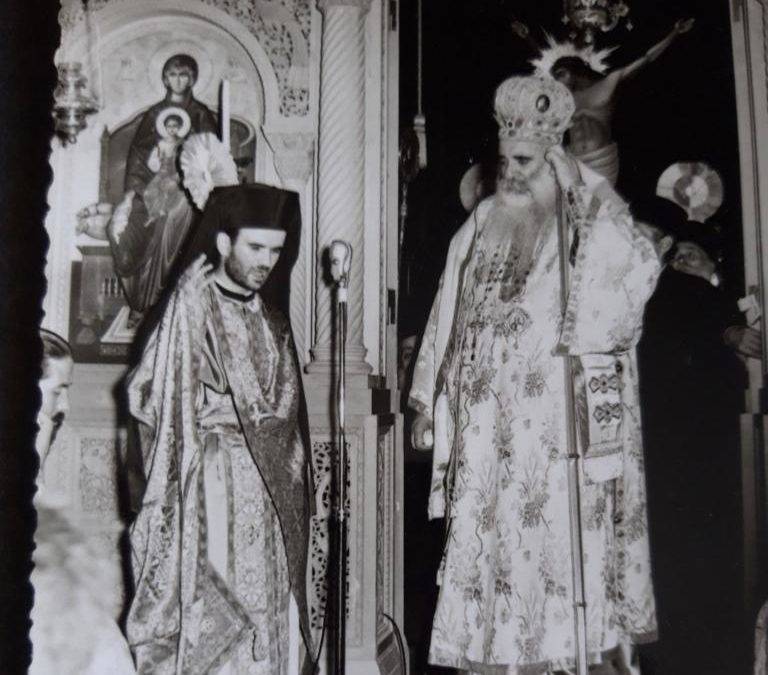
Metropolitan Amfilohije on the feast of St. Procopius was ordained a hieromonk in Kefalonia
Remember your elders who preached the word of God to you, looking at the end of their lives, imitate their faith (Heb. 13, 7).
On this day, on the feast of the Holy Great Martyr Procopius, in the summer of 1968, Metropolitan Amfilochia was ordained as a hieromonk in the Cathedral of the Metropolis of Kefalonia, dedicated to the Annunciation, in the city of Argostoli, in Kefalonia.
On this occasion, we remind you of the conversation that Archpriest Nikola Pejović, editor-in-chief of Radio Svetigora, had with Metropolitan Amfilohi on July 21, 2018. The Metropolitan talks about his ordination, his encounter with Greece, his pastoral experience, his first parish, meetings with great Greek fathers and preachers of that time later recognized as Holy Elders, acquaintances with people like Alexander Solzhenitsyn...
+++
Bless! What were the impressions of your meeting with Orthodox Greece in the 60s of the last century?
May God bless with the prayers of St. of the great martyr Procopius. Well, I'm just amazed that 50 years have passed since that day and that act. I was previously ordained as a deacon in the Monastery of St. Gerasimos of Kefalonia, a great saint and educator, on the eve of the feast of St. Prokopia in Argostoli — a small town in Kefalonia. I was ordained by Metropolitan Procopius, who played a significant role in my life. At that time, in 1966, I came from Rome (Italy) to Greece and I was at the crucifixion. I have to say, I didn't want to go back to communist Yugoslavia, but then I even threw away my Yugoslav passport and got a blase-passe - an emigrant passport, thanks to Metropolitan Procopius. There was his schoolmate Zoe Chronopoulou who was our great benefactor and friend, and later she was a nun - abbess of the Monastery of St. The Trinity in Attica. She first met the former bishop of Zahum-Herzegovina, Atanasi, who was there before me. She came to the Russian church where he served, confessed with him and heard about Father Justin through him. After that, she went to Ćelije every year and secretly. She goes to Vienna and then returns to Belgrade, where they wait for her in the evening and drive her to Ćeli. And so one year, she became a monk there and was named Justina, after her father Justin. She always brought us letters from Justin's father. Secretly, it was not even known. She studied together with Procopius, later she was a professor of religious studies at the gymnasium for decades. And so, through him I met Metropolitan Procopius. He supported me and helped me as much as possible before the state authorities, because he was a military priest and a clergyman in his time. So, thanks to that, I reached Kefalonia. I was counted as a monk there, when he made me a monk secretly.
You decided to choose a monastic vocation while still in Rome?
In Rome I decided and then wrote a letter to Father Justin. He sent me an answer to that letter in a flash. His famous sentence from that letter, which I constantly repeat to myself and to many of whom I am now a monk: "I am glad that you saw yourself from the point of view of eternity." This is his answer to me who was in Rome. Then, with his blessing, I went to Greece. So it happened in 1966, and then in 1967 I submitted my doctoral thesis there. We stayed there for a while with Konstantin Geilis. It was a priest, a wonderful old man, and now he is alive. A family man and Ana, his wife, a wonderful honest woman. He even founded a monastery. Afterwards we stayed in St. Paraskevi, it is a small house where Atanasije and I stayed years later.
All this happened in Athens, in that house Prokopius made me a monk in 1967, of course with the blessing of father Justin. Then, in 1968, I registered there, when I became a monk, that I was a brother of the Kipureon monastery. It is a monastery on the sea in Kefalonia and it is the only monastery where I am officially registered as a monk. That's why I say that I would love the most if you knew when I'm going to die, to go there to rest in that Kypureon monastery of mine. In that monastery was the monk Eusevije, so he says, "When you will come, when you will repent, come to your monastery - to the monastery of your repentance". By the way, the abbots of that monastery used to often go to Russia in Turkish and Venetian times and had live contacts with Russia, bringing help to the monastery, Kefalonia and other places.
So it is the 68th year of St. Procopius, 50 years ago. Then, with the blessing of Procopius, I was ordained in Argostoli. And there I served the first 40 Liturgies and every year during the summer I went to that monastery of mine, especially when Prokopius was there. Later, he was accused of sharing the relics of Saint Gerasimos of Kefalonia, and it seems that I succeeded him in this as well, because now I am also accused of devastation of the cultural treasures of Montenegro. And he had infinite respect for relics. Like me when we are the relics of St. Vasilija was carried from Ercegovina, these were entire inscriptions, who is allowed to carry St. Vasilija to his village and to Tvrdoš - which was his monastery, but it has now turned out to be a historical event and thanks to the transfer of the relics, Nikšić became a second city. When we were coming back, there was that burst of clouds, and all of Nikšić came out. Even today, I have before my eyes the picture and those children on their knees and what they say rain falls from the sky from the earth and the people expect and heal St. Vasilija and thus this liturgy became the most significant event not only in Montenegro, which gathers over 30-40 thousand people in Nikšić every year during St. Vasilij Ostroški. So, that stay in Kefalonia remained deep in my memory, I celebrated my first liturgies there, and the people of Kefalonia are wonderful, exceptional, virtuous and pious people.
Where did you get your first pastoral experience as a hieromonk, did you also have a parish?
As a hieromonk from there, after I was in post-graduate studies in Athens with the blessing of Kefalonia, Metropolitan Nicodemus of Attica received me as his wingman and appointed me to the village of Koropi where I was a parish priest for five years. I baptized and married tens of hundreds of Greeks there and today they consider me their priest there. Then they said "That's our pop Montenegrin". These people of mine deprive me of the name that I am a Montenegrin and attack me, they even declare me an occupier, and now they are going to Koropija, where I visited all those homes, everyone remembers the Montenegrin priest, Papas Mamavrunios.
Was it a large parish?
A large parish, there are 25 temples in that small town and the surrounding villages. I guess I'm the first priest who served all those temples alone at that time, and that's why I'm remembered. It is their custom to go as a family, open the church, prepare everything needed for the Liturgy, incense, candles, prepare prosphora and wine and everything you need, so you just come. And then the awards, of course, of the priest. They are pious people. I spent those five years there, and for the sixth year I was a preacher in Koropi - a neighboring village where I preached to the people every Sunday, especially during Great Lent, with the blessing of the Bishop. The people gathered in one of those churches and in a hall, and then I preached. So at that time, my pastoral work was related to Spata and Koropija, and then also to the monastery of St. Trojice. There was Justin's mother abbess, appointed by that same Bishop. She passed away a few years ago, but the sisters are still there today. I feel them as the most native, as my own here and her too. She took care of all of us who were coming to Athens. There was not a single minister or prime minister without her answering the phone. I promised her that when she died, I would answer her phone instead of a tombstone... I remember one from Macedonia who fled to Sunio, from here in Macedonia with the desire to go to Mount Athos. But since he was from Macedonia, the Greeks did not want to let him go. He fled twelve times on foot from Sounion to Mount Athos, they found him there and brought him back. She took special care of him. Later, these Macedonians of ours, when he returned from there, he could not go to Mount Athos, they ruled him here. He died as Bishop. I hear that they speak of him as a Saint... and he was truly a man of God... one soul of God.
As a very active hieromonk and preacher, did you have the opportunity to meet and get to know the great Greek fathers and preachers of that time, later recognized as Holy Elders?
It was a special blessing. I had the honor of meeting the most significant, let's say, clergymen of the twentieth century. Let's mention the old man Paisius, who is now included in the image of the Saints I was with. That very year when I was ordained, I went to him. Katunaki, it is under Aton, down where he was. There were the cells of some Romanians that were abandoned. He was the first to go to restore them, and then I went to his place and stayed there for a week and saw how the real hermits of Mount Athos lived. I brought some fish, sent Mother Justina for Father Paisius and me, who used to go to confession with Father Paisius, and through her I met him. However, I didn't eat those fish, nor did Paisius...he had one little Snešek - a kitten, and every day when he prepares something there, there is no fish for us, but there is some for little Snešek. Then he says: "Justina is sending, don't worry Sneško, there will be more fish", and so Sneško ate that fish and we didn't try it, neither me nor father Paisija.
There I also met other hermits there, the elder Ephrem and later of course the elder Porphyry, who is also now included in the image of the Saints, but he served in Athens. I went to confession with him there below Pendeljis, there is a small monastery that he renovated when he retired from the hospital. Then other elders, the elder Epiphanius Theodoropoulos, a wonderful exceptional jurist, the best canonist that Greece has had in recent times. He wrote dozens of books on ecclesiastical law. It was the spiritual center of the Holy Three Hierarchs where he served and where people gathered around him. Then other extraordinary people. Elder Emilian... I met him at Meteori, he gathered the brothers and sisterhood there, so Atanasije and I went there to see them and later remained attached to them to this day, especially Atanasije. And the Ormilije women's monastery has about one hundred and fifty nuns. Our nuns and monasteries are connected to them, especially Ćelija Piperska. In May of this year, I visited old man Emiliano. He is an exceptional personality, there are his books that have been published in our country. God allowed him to be tempted, he is motionless like a plant. He recognized me, he recognizes someone and most of the people who come to him, and they don't come to him much, the sisters take care of him. Father Emilian is in such a state.
At that time, one of my first encounters was with the old man Amphilochios on Patmos. Elder Amfilohije, an exceptional clergyman who was also a missionary, organized missionary brotherhoods and sisterhoods that are still functioning today. One of his spiritual sons is Amphilochius who is now the Metropolitan in New Zealand, a good friend of mine. I went to confession with him, even then I didn't know Greek very well. I knew that from classical philology, so I communicated with him. I have to admit that it was the most shocking confession I had in my life, what I told him. I came from the West, and then I told him, what I didn't tell him... I thought he would forbid me to take communion, I thought he would give me some kind of penance, and he says: "Brother Risto, shall we take communion tomorrow?" I, as they say, could not have been better pardoned by the old man Amfilochia. Then we took his picture to Father Justin. And when I asked father Justin for a name, he counted Grigori or Amphilochius, but the father from Patmos ruled that I should be named Amphilochius of Iconium...yes...so Amphilochius.
Then also the old man Philoteus from Samos, an exceptional personality. A great priest on the island of Samos who lived there on a mountain. I went there with him. After that, there was still an outstanding priest Philoteus, an old man, who lived in Athens. I was with him there on the island of Samos, one year I was in his cell for confession. On one side of the cell is his bed and on the other is the grave. Afterwards I said, "Old man, why did you make this grave here?" and he said to me, "Monk Amfilochius, I have tried all my life not to be a burden to anyone, but to take care of myself. Well, now if I knew, but I'm not so holy that the Lord would tell me when I'm going to die, so instead of lying down here in bed, I'd lie down in the grave. Well, since I won't know that, I guess I deserve so much to be moved out of bed, but don't bother too much, don't carry me, but place me here immediately". He was buried there. The old man Philoteus was taken from that grave and placed here. There were really wonderful priests...
So did the elder Nicanor in Hilandar and other brothers. There was a monk of ours from Montenegro, Kuč, a very interesting old man. He later passed away, but the old man Nicanor, who spent 60 years there in Sveta Gora, Hilandar, then came here in the old days and toured Dalmatia, was also in Montenegro, Ostrog monastery, Serbia. And our Mirko Toljić, as a young student, made crosses on his order. Wonderful wooden crosses in which he put a piece of relic, a piece of Christ's cross, and he later carried those crosses to Novi Sad, Kraljevo, Dalmatia. I think there is one in Cell Piperska as well. Then he carried and gave when there was that schism with the American diocese, but he asked me, "What should I do, should we assume that there was no contact between the official Church and Dionysius?" and I tell him "You are from Svetogore, you will know it best". There is one such cross of Elder Nicanor in Nova Gračanica.
Then when I was Bishop in Banat, sometime in 1987-1988. year, here is the old man Nicanor, who was nearly 80 years old at the time and used to come to the Rakovica monastery, he stayed there because he was in the hospital due to heart problems. I was happy. We founded the Hajdučica monastery there, our Grigorije, which is now in Starčeva Gorica, he was the first abbot of that monastery and that is the metoh, I don't know if the current bishops remember it now, but it is the metoh of the Hilandara monastery. Some of the monks went from there to Hilandar and stayed on Mount Athos, and that was the goal, to prepare monks for Hilandar there. Therefore, Nicanor came to me over the summer and said to me, "Lord, I have come to ask you for a blessing." I had the intention of going to Australia and taking that cross, you already know how I make those crosses. The doctor forbade me and said it was no accident, so I came to you to ask what I should do?" I say to him "Where did you find me yellow-billed, you old Svetogorac, to ask me for a blessing" . "Let the fact that you are young, you are a Bishop and I respect that. I have never done anything without blessing, without obedience in my life, so I will not do this either."
When I asked him what he thought, he said, "I would like to go. I feel that it is the need of our people to go there", since that schism was created there as well. So I say "What if you die there, what will we do?", and he says "If I die there, bury me there, if I die in the Holy Mountain there, everywhere is the land of the Lord". So I said, "Old man, if you think it's good, as far as I'm concerned, go and here's a blessing for you." He was all happy, like a little child, that he received the blessing and left. He stayed there for two months and died, and today he is the only Svetogorac in the monastery of St. Sava in Ilain, the monastery that the latter bishop Nikolay of Dalmatia and Dabro-Bosnia founded, he was buried in that monastery and his relics are there. Many people come there and pray at his relics, especially the Greeks. They, the Greeks, immediately recognized Bishop Irinej, who was there and is now in America, and he even proposed to the Parliament that he be canonized. It was considered at the Parliament that it is too early since some bishops know him, so, come on now, since they know him, he cannot be a saint...yes. Well, we all know Patriarch Pavle, but there is no doubt, no dilemma, that he is a saint. It was already at the VMA when I was replacing him that year, then we did a chapel at the VMA dedicated to Luke the Doctor of Military Asylum, it was with my blessing, and they already painted him with a halo there, the icon painter asked me, I said paint it. In a series of churches, there is St. Dimitrija in Mitrovica and here with us in the Church of Christ's Resurrection and elsewhere.
The people recognize it best.
People and not only here, but everywhere in Orthodoxy. Likewise for old man Nicanor, a wonderful man of God. I remember him in Hilandar. He was always the first to attend matins, which on Hilandar is there after one o'clock according to our time, then to the service all night, he was the last to leave the church, that was known. Elder Nicanor was highly respected in Athos. Then he left his mark here as well as other Svetogorians who did ascetics there and then came here. There is Saint Raphael of Banat in Banat, in today's Zrenjanin, where his relics are, who was canonized. I printed a book about Saint Raphael with his life and ministry. These are all wonderful people, a truly great blessing from God for me is staying on Hilandar.
It is especially big when you compare the situation you left behind in the then godless Yugoslavia.
Well, that, thank God, was a saving grace for me, godlessness literally reigned. I have to confess and confess, and why not, I also had the intention of staying in Greece, Mount Athos, but I didn't want to according to my own mind, instead I wrote Father Justin a letter "My wish, but I won't without your blessing" and he to me answered "You should come back, you should come back here, both to us and to you".
What was one type of punishment for you?
Well, at that moment, to be honest, yes, but now I am grateful to God that I listened to him.
I'm talking about your priestly service, which, thank God, has lasted for 50 years with great fruits and gifts, how much did the meeting with those elders of different gifts, different characters of nature, influence the formation of your personality and mission?
Well, it is of great importance. Starting with Father Justin, whom I met when I was in Belgrade in 1959 for the first time, when the current Atanasije was a monk, then we went via Lelic, where Bishop Nikolaj was born. I remember Justin walking like a doe, so I ask him "Father, why do you like a doe?" he wrote the famous essay The Doe in Paradise Lost and he says: "I love the doe a lot" and it really is a wonderful animal. And that meeting with him, of course, was decisive for that time when we were under attack in Belgrade. Our faculty was banned, no one was allowed to come. Some of our intellectuals who are now members of the church, but then they were not allowed to come to the university, started to come a little later. That time, that terrible pressure of communism and all those bolshevik ideologies, then the study of theology and all that was happening and the meeting with those real people of true deep - experienced faith and not just bookish faith, that is of enormous importance.
That meeting with them seems to have determined your academic path, the very choice of doctoral dissertation - topic, that gift of achievement?
Absolutely. When we mention those wonderful people, later in Paris, where I spent a year teaching at the Saint Sergius Institute, I met a lot of Russians, former emigrants who were very important, and there I met Solzhenitsyn. I remember that in 1974 he came to the place where there was a famous Russian bookstore, which is still famous today. There was a certain Nikita Struve, the editor of a magazine in Russian that was published in the bookstore. And he brought Solzhenitsyn to meet. We met, there was Komnen Bećirović, the famous defender of the Church on Lovćen and Morača Monastery.
Father Paisija made wonderful crosses and made a wonderful wooden cross, and then what will I give to Solzhenitsyn and then I will write an Aphonian cross to Alexander the cross-bearer and give it. He kissed him, took it, and I saw that when I was with Athanasius at his place in 2003 to present him with the Order of Saint Sava by decision of the Holy Synod of Bishops, I saw that he had that cross with him. Solzhenitsyn is an exceptional person, then he sent Father Justin one of his books, and we found a book by Dostoyevsky about Europe and Slavs, so we gave it to him and he sent his greetings to Father Justin.
There we met an old man Raphael in the women's monastery of Bisij not, where there were sisters who in their time came from Ukraine to the monasteries of Kuvezhdin and Hopovo. Several hundred nuns who fled from the Bolsheviks through Romania were received by our Mother Teodora on Fruška Gora. During the war, the Ustasha imprisoned them, then released them, and they were also in Zemun until our communists expelled them in 1948. Then they went to France, where their monastery was an important spiritual center. And there was an old monk, their spiritual leader as well, an extraordinary person. I remember we serve there in their church, and as he says, one of our priests, a Serbian, Russians, and God gets bored with his prayers - a long service, but the 93-year-old man stopped and read hundreds of names throughout the Liturgy. Then there was Metropolitan Philaret of the Russian Church Abroad to which that monastery belonged, and after the service we all went to lunch. Russians usually all the faithful who were at the service go with the Metropolitan, but there is no elder Raphael. I ask mother Teodora where he is, and she tells me that he never comes, but they take him to his cell to eat something. I ask what she is doing and she tells me that she is praying. "Well, didn't he pray", I say and ask to go to him. I go to him in the cell. He didn't hear well, so I shout: "Bless the Old Man" "God Bless". I asked him if he wasn't tired, and then he told me, because he had already been in the monastery where he came from Russia for 80 years: "Well, I tried, I won't say, but now if I could start all over again, it would be a lot better. What I missed during 80 years, I now have to make up for it". He was 93 at the time, and in 97, the old man passed away in that monastery. It is a gift from God when you meet such wonderful and wonderful people.
That meeting with the saints somehow broadened your soul and care not only for the people entrusted to you and the diocese, but to see the Church as the true body of Christ where every member is important. How important is that to the modern Christian in this era of selfishness?
Indeed it is. This has never been more important than today in our time for the Church, and the Orthodox Church has never been so widespread in the world as it is today. I understood what that mission means through those holy men of God. Let's say that in Holy Mountain where there is no difference between a Russian or a Serb, a Bulgarian or a Ukrainian, or a Greek. Christ is one, and now that there is neither male nor female, nor Greek, nor slave, nor free, as the apostle Paul says, and then you understand it through those holy men of God, their responsibility for the whole world. Well, here is Father Paisius, when we mention him, he said to me once, "They keep convincing me, they say Father Paisius, you have these gifts, why don't you go somewhere to be ordained as a priest, and then be a priest in a parish. They want to reduce my mission to a parish in Greece. There is as much as you want for that job, and I feel responsible for the whole universe, for the whole world, for Japan". Such responsibility is the Gospel, the Church. This is something that I actually learned first from Father Justin, who was a real man, it can be seen from his writings, a universal, universal philosopher and thinker, like the others I met and knew.
Then when I went to Argentina for the first time in 2007, I realized how neglected our people are. For 100 years there, no one practically took care of him, and at the same time, I met Argentinians there, our people who became Argentinians, they don't know our language anymore, they don't know anything. At the same time, many of them converted to Catholicism, became part of some sects. No one cared about them. Then I felt a responsibility for those people, and then it pulled me to propose to the Assembly, and I thank the Assembly for accepting, that the Eparchy for Latin America, Buenos Aires, Central-South America, be founded. Since 2011, I've been going for a month or more every year, I've visited a large part of those countries. Now we have the gift of God, that our bishop Kirilo, who has been my assistant vicar there, is now elected, at my suggestion, as the first regular Bishop in Latin America. I sometimes joke a little and say "this here, this Broz's "fildžan Avnojevska" Montenegro was small to me, so I had to expand my mission to Latin America.
What you brought to Montenegro and what you set it on fire is the truth that what is God's seed is that it is indestructible.
God's is indestructible. That is crystal clear. I remember coming to Podgorica as a student. You couldn't see the little church anywhere. Hardly the little one up there, and five people never came to it, and now all these churches that used to sing, and here is this Church of the Resurrection of Christ, which is now the decoration of the capital city. Now even those who hate the Church, Orthodoxy, have nothing to show in Podgorica to their guests from the NATO pact and other international organizations, except for this temple. What do they have to show? They have nothing, their ignorance.
Thank God, I still count that God will give it to us while I am, even though I have turned 80 years old, but I said to the Lord, "Don't touch me until I return the Cross and the church of Saint Peter the Second and his relics to the Church on Lovćen". Well, God will give. Then we also have the Church of St. Archstrategist Mihailo in Prevlaka, a monastery where the seat of the Metropolis was for 200 years. We are ready to restore everything, but those from the Administration for Cultural Assets are not giving. What should I do? I will listen. I hope they will understand that ruins are not culture. Admittedly, there is a document from 1988 where the Institute for the Protection of Monuments in connection with the Stanjevići monastery, which is now restored and more beautiful than ever thanks to father Dimitri who embedded his bones in it and father Jefrem and other brothers, wrote about that ruin which remained after the demolition during the nineteenth century that it should not be touched "it will be the most beautiful ruin in Montenegro". Well, if I had stuck with those security guards, especially these in recent times. The previous ones, let's say the one of Chilikov, they were educated, they knew their profession. When there were questions about the church, the Majstorovina monastery, and the Voljavac monastery, they did not have experts, so they hired Jovanović and others from Belgrade. They gave their projects and we rebuilt those two ruins and several others like that. May God live, I hear that now they have dismissed that Miranovićka, the fashion designer who forbade, blocked anything to be done, these are ruins - this is the culture.
Somehow they present to the public as if the church is not ready for an agreement, and it is exactly the opposite. How long were we waiting for the permission of the Church of St. George in Njeguši?
I have sent hundreds of documents and I have not received any response until today. Here is also the question of, say, the Holy Archangels, they literally do not give. We have to fight. I want to, really. We involved the best experts, archaeologists in the restoration, excavation, research... We built the crypt there, the monastery treasury, it is already being finished these days and God willing, on the 26th, when the Orthodox Youth Assembly is held, the treasury will be opened, but we expect to get permission. We have a project. Zdravković, the architect, is the best connoisseur, he rebuilt and excavated Carica's city, he knows the architecture of the ancient East and West. He made his proposal now. So we have to finish the Holy Archangels and the Church of the Holy Trinity in Cetinje. Those three things are still on my heart. I have to admit, because this current Minister of Culture, who is attacking me, I see the dog cart that they say, Bogdanović, he received, I heard, even some million and how many euros to stuff the Virgin of Filermos into the cave, where the volcano erupted when there was a flood in Cetinje, from where underground water springs. And he wants to put an icon there, supposedly for religious tourism, and then, he believes, all of Europe will rush. Which Europe will rush? Even now, that icon is still there, there are other shrines. The one who still has a little fear of God and love for the holy comes. Today, Europe started down a dead end. It's a shame that we are now getting involved in such and such Europe. There is no Europe of great miracles, the Europe of the apostles Peter and Paul, the great Popes Gregory the Two-headed and Zachary the Pope, all there until the tenth century and even after that. Shakespeare's Europe, Dante's Europe, Goethe's, the great heroes of Joan of Arc, de Gaulle...
For us, it is a great joy and blessing of the Orthodox believers that the Patriarch arrives, the ordination of the newly elected Bishop Methodius, and that is what makes us happy.
That's a big deal. However, those who now proclaim themselves to be from Dukljan, what do they have besides the stories they only tell about the cursed emperor of Dukljan? They base their debt on him. And, the Church of God continues the holy work of ancient Diokleia. Our Metropolis has also returned the title of Diocletian bishop, until now it was Bishop Kirilo who is now here preaching the Gospel in Latin America, and now our Durmitor is coming so that they don't say he is an "outsider" but from Durmitor, our father Metodije, abbot of the Cetinje monastery. He comes here to help this holy work. There are beautiful gifts, God will give them!
Bishop, thank you for your time, may the Lord strengthen and protect you and let us celebrate together many more jubilees to the glory of God and the joy of the Orthodox Church!
God grant that we realize the Holy Archangels on Prevlaca, the Church of St. Peter of Cetinje, which was designed by Bishop Rada and is the first church dedicated to St. stuff into the cave as if we are Cro-Magnon people and not Montenegrins as they say are real, and part of the Holy Cross. Up there will be a three-nave basilica, and three sanctuaries, to be a decoration above the Cetinje monastery, to level the rock that was demolished for the sake of the church, where the Turkish heads are hung. There was that famous board. The place where heads are hung in the church. Is there anything more beautiful and blessed for Montenegro and for Montenegrins. I don't think there is.
Thank you and bless you!
God bless!
PHOTOS
RELATED ARTICLES
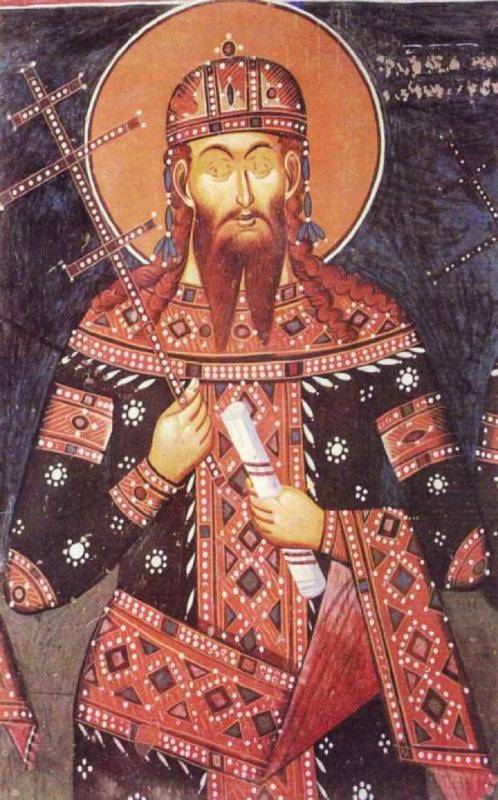
Calendar for December 15 Saint Emperor Uroš
The only son of the Serbian Emperor Dušan and Empress Jelena, sister of...
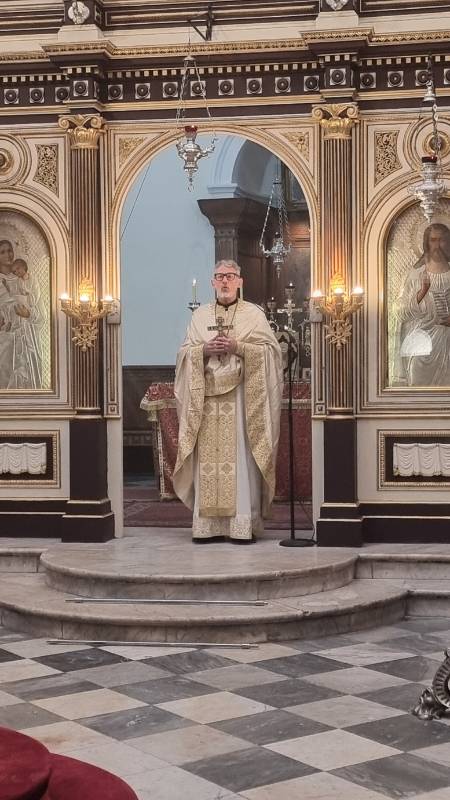
FATHER NEMANJA KRIVOKAPIC: BY PUTTING FORM ABOVE ESSENCE, ALL BECAME HYPOCRITES SIMILAR...
“Whenever we think about the miracles performed by the Lord, such as the...
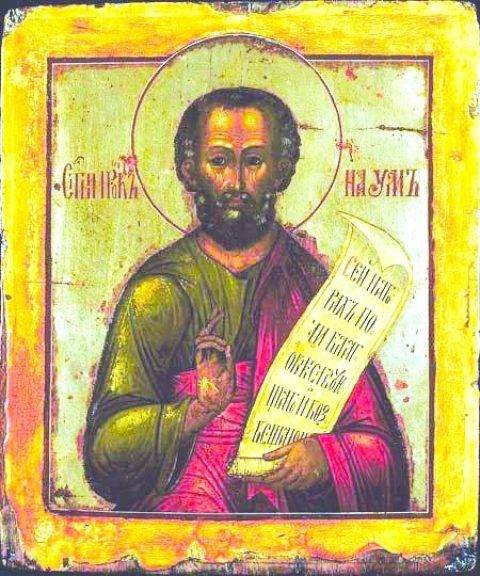
Calendar for December 14 Saint Prophet Nahum
A native of the town of Elkosh, across the Jordan, from the tribe of Simeon. He...


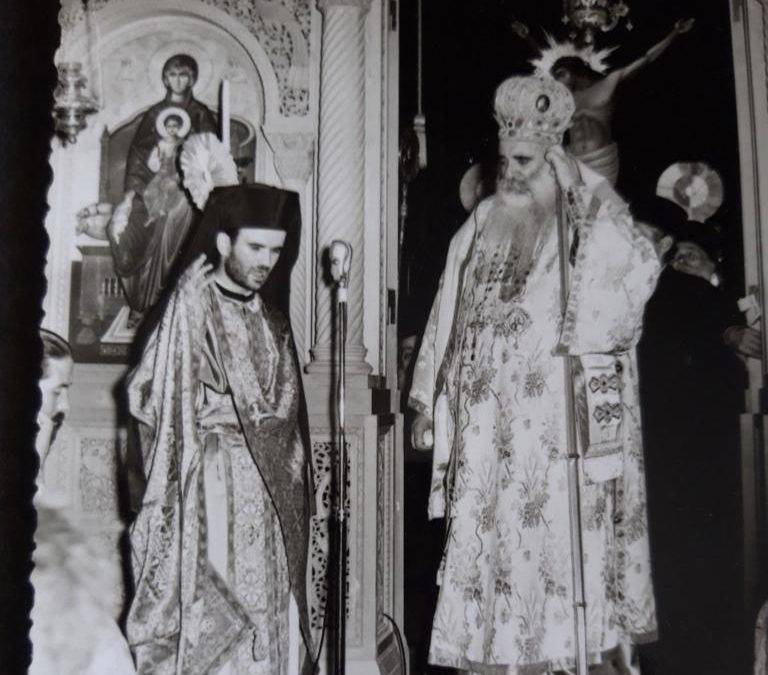

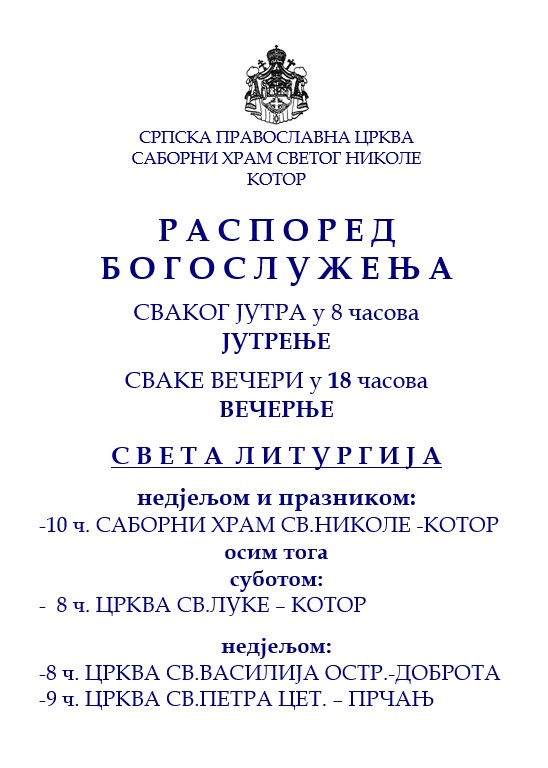
.png)